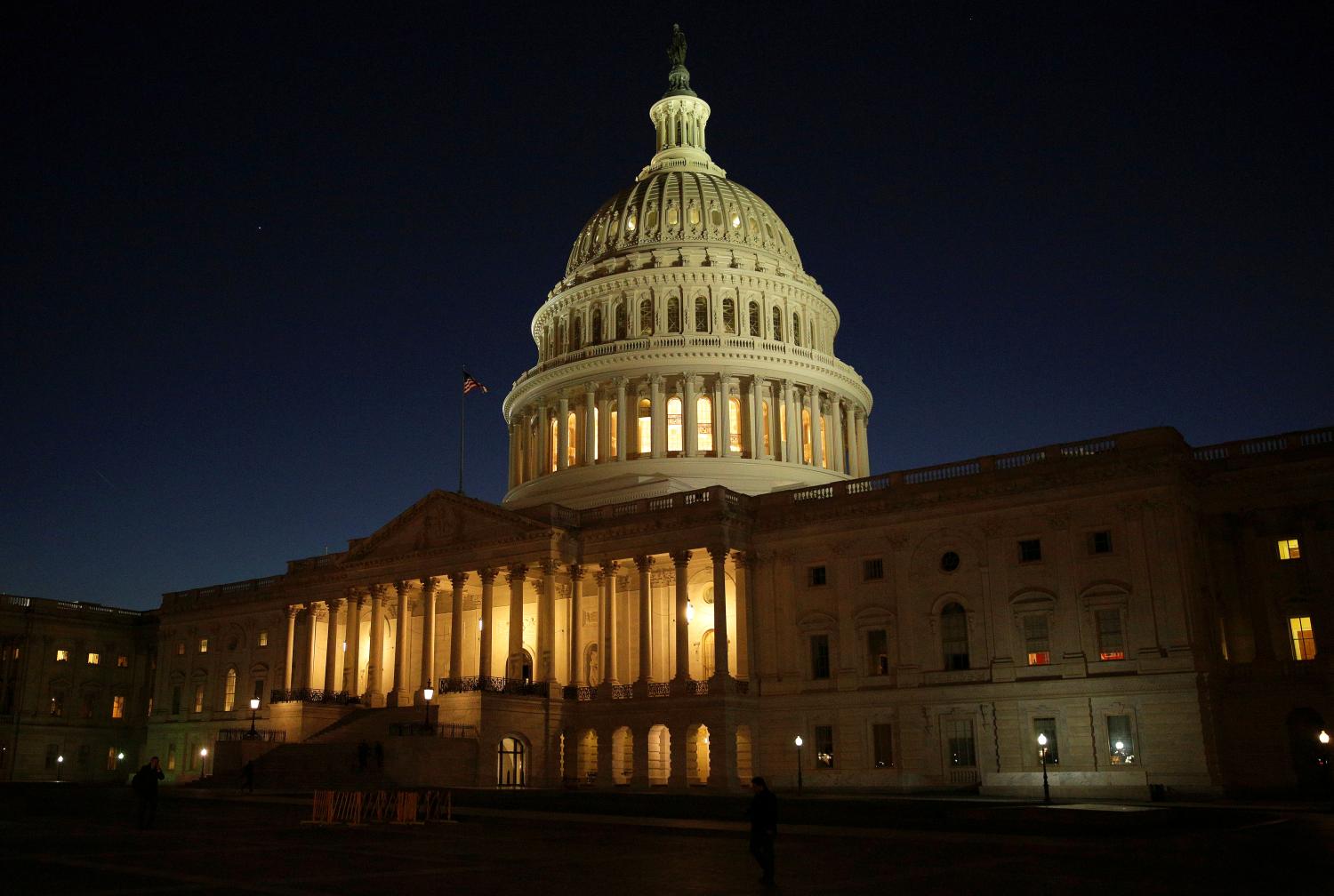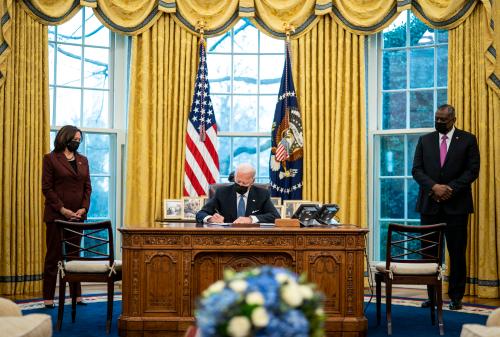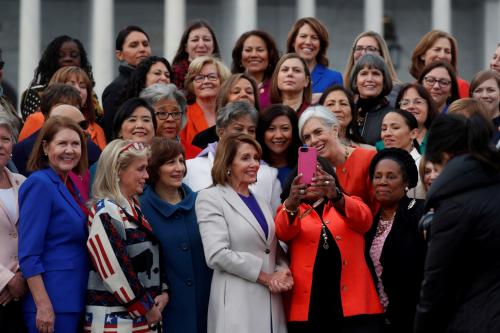In recent decades, the Senate has confirmed at least a few Cabinet secretaries on the president’s first day in office. President Trump had two in place by the day’s end: Defense Secretary Jim Mattis and Homeland Security Secretary John Kelly. President Obama had six of his picks confirmed. President Biden, however, had none until his third day, January 22, when Defense Secretary Lloyd Austin cleared the Senate. A few days later, the Senate confirmed Janet Yellen, the first woman to serve as secretary of the treasury and then Antony Blinken as secretary of state. By the end of President Biden’s second week in office, the Senate added Pete Buttigieg and Alejandro Mayorkas to lead the Department of Transportation and the Department of Homeland Security, respectively.
Like past presidents, President Biden has had to rely on acting leaders to take charge of the fifteen Cabinet departments. After taking his inaugural oath, he announced he had two holdover Senate-confirmed officials from President Trump’s administration at the Departments of Defense and Homeland Security. The rest of his acting Cabinet leaders are senior agency officials entitled to serve under the Federal Vacancies Reform Act of 1998 (Vacancies Act). One, Phil Rosenfelt, headed up the Education Department at the start of the last administration as well. Including Rosenfelt, President Trump turned to nine non-confirmed agency officials four years ago. At the Departments of Agriculture and Treasury, those acting secretaries served for months.
With hundreds of key Senate-confirmed jobs to fill, as well as the demands of the second impeachment trial, the Biden administration will have to depend on acting officials where it can to keep the government running and reorient its activities to reflect the new administration’s values.1 For regulatory priorities such as climate change, agency work will have to proceed without top-level leadership even though the White House has made quick nominations. Unlike Presidents Trump and Obama, President Biden formally submitted nominations for all fifteen top Cabinet department jobs (plus another twenty-two positions) on his first day.2
In this report, I sketch some of the ways the new administration is using temporary officials while the traditional appointments process churns, some potential legal challenges, and avenues for bipartisan reforms to the Vacancies Act. I conclude with a reflection on whether increased use of acting leaders essentially solves the problem of having too many Senate-confirmed positions.
Use of Acting Officials
Since 1998, the Vacancies Act has allowed certain officials—first assistants, other Senate-confirmed appointees, and certain senior agency workers (political and career)—to step into covered Senate-confirmed positions at the start of an administration for 300 days, which can be extended for considerable periods of time if formal nominations are submitted.
Despite a switch in parties, both Presidents George W. Bush and Obama initially kept on three deputy secretaries (first assistants to Cabinet secretaries) from the previous administration to serve as acting secretaries. Presidents Trump and Biden each relied only on one, at the Justice (short-lived tenure of Sally Yates) and Defense Departments, respectively. Presidents Bush and Obama drew from other Senate-confirmed officials appointed by their predecessors for the rest of the vacant Cabinet secretary slots. Presidents Trump and Biden turned instead to senior agency workers, presumably because of political preferences. Specifically, on the demand side, it was likely easier to find a senior agency worker aligned with the new administration’s priorities than an appointee chosen by a president of the opposing party. On the supply side, the outgoing administration’s appointees may not have wanted to serve in the new administration, even for a short time.
No president seems to have yet utilized another option available under the Vacancies Act: to name a commissioner or board member as an acting Cabinet secretary, assuming no agency-specific statute precludes it. Due to party balancing mandates at many agencies, an incoming administration could find a Senate-confirmed official from their party. For example, President Biden perhaps could have turned to one of the two Democratic commissioners at the Postal Regulatory Commission to serve as an acting secretary.
President Biden has relied mostly on senior careerists as acting secretaries, though one senior agency worker was a non-confirmed political pick of the previous administration. At the same time, the White House has put political allies in place in many non-confirmed first assistant positions, allowing them to also take on the higher Senate-confirmed jobs in an acting capacity without any additional presidential action. For just two examples: Laura Daniel Davis, a former chief of staff to Obama administration secretaries at the Department of the Interior, is now the principal deputy assistant secretary and acting assistant secretary for land and minerals management there; Suzanne Goldberg, formerly co-director of Columbia Law School’s Center for Gender & Sexuality Law, now serves as the deputy assistant secretary and acting assistant secretary for strategic operations and outreach (and the Office of Civil Rights), at the Department of Education. Where first assistants could not be quickly replaced, President Biden has used his authority under the Vacancies Act to name acting officials for lower-level positions as well, including Susan Orsega as acting surgeon general.
Finally, President Biden has created some vacancies in term positions that arguably lack removal protection to install preferred acting leaders at the Consumer Financial Protection Bureau (CFPB) and the National Labor Relations Board (NLRB). After CFPB Director Kathy Kraninger resigned at the President’s request, the President named Dave Uejio, who joined the CFPB in 2012, as acting director until the Senate confirms Federal Trade Commissioner Rohit Chopra for the new post. President Biden fired NLRB General Counsel Peter Robb after he refused to leave, and then removed the following day his political deputy who had stepped into the acting role. On January 25, the White House named Peter Sung Ohr, a career official, as acting general counsel. (The NLRB general counsel is a rare position in an independent regulatory commission covered by the Vacancies Act.)
Potential Legal Challenges
The Vacancies Act got more use and generated more legal challenges in the previous administration than ever before. The recent attention to the use (and misuse) of acting officials under President Trump could generate lawsuits challenging the Biden administration’s recent actions in at least two areas: the use of non-confirmed officials to head agencies and the applicability of the Vacancies Act to presidential removals.3 Indeed, a shipping company formally challenged Robb’s firing in front of the NLRB on January 25, claiming that it could not continue to be prosecuted for labor violations. While the company did not challenge the acting service of Ohr under the Vacancies Act, such claims will presumably soon follow, as discussed below.
First, while the Vacancies Act permits the president to choose non-confirmed senior agency officials as acting Cabinet secretaries if they have served at least 90 days in the year before the vacancy and are paid at the GS-15 level or higher, the Supreme Court has not clearly ruled that such officials are permitted under the Constitution’s Appointments Clause, which requires principal officers to be Senate-confirmed or recess appointed.
When President Trump chose Matthew Whitaker as acting attorney general after pushing out Jeff Sessions in 2018, many challenged Whitaker’s selection, arguing that his lack of confirmation to any agency post made his acting appointment unconstitutional. Every lower court to rule on the constitutional claim upheld Whitaker’s service, relying on the Supreme Court’s 1898 decision in United States v. Eaton, which seemingly treated someone serving temporarily in a principal office as an inferior officer.
Conversely, nearly a century later in Edmond v. United States (1997), which did not involve acting service, the Court determined that inferior officers are “officers whose work is directed and supervised at some level” by someone other than the president. That description would appear to exclude acting secretaries.
Would the Supreme Court side with Eaton or with Edmond today on whether acting Cabinet secretaries and heads of other freestanding agencies are inferior officers? Under the Appointments Clause, the Vacancies Act’s provisions meet the mandates for inferior officers. The Office of Legal Counsel has held that temporary acting service in principal offices is constitutionally permitted; I agree. But others disagree, including Justice Thomas. Given the administration’s commitment to quick nominations and Democrats’ narrow control of the Senate (with the vice president’s tie-breaking vote), it is unlikely that a non-confirmed official would serve long enough as an acting Cabinet secretary to allow a case to reach the Supreme Court on this issue.
Second, the Vacancies Act does not explicitly mention presidential removals; rather, it permits acting service when the previous covered officeholder “dies, resigns, or is otherwise unable to perform the functions and duties of the office.” Does that last phrase permit the president to fire an officeholder (assuming no other constraint on removal) and replace her with an acting official under the Act? We have no judicial decisions on this issue, even from lower courts, leaving the question in some doubt.4
After President Trump removed David Shulkin as secretary of veterans affairs, he used the Vacancies Act to install Robert Wilkie, a Senate-confirmed Defense Department official, as acting secretary. Some veterans sued, claiming that the Vacancies Act was unavailable and that an agency succession provision required the deputy secretary to become acting secretary instead. But they gave up their case when Wilkie was later confirmed to the job.
Limited floor statements from the Vacancies Act’s legislative history support its application to firings. The government and I have argued that the text also helps, as someone who is removed from her job is “otherwise unable to perform the functions and duties of the office.” Others worry about the incentives this position creates, encouraging presidents to fire officials and use acting officials instead, though it does allow presidents to fire truly “bad apples” and replace them.
This issue will presumably be litigated as the NLRB undertakes new enforcement actions or continues to prosecute existing actions. Although the shipping company challenged only Robb’s removal, it could have easily raised a statutory claim about the acting general counsel given the firing. Because the general counsel position is arguably a principal office, we may also see a constitutional challenge to the use of an unconfirmed career official in that job in an acting capacity. Unlike the Cabinet, where the White House has sent formal nominations to the Senate, the delay in nominating someone for the NLRB general counsel job could increase the chances that these legal issues reach the appellate courts, if not the Supreme Court.
Avenues for Reform
With the new White House and Senate, this may be a good time to consider bipartisan reforms to the Vacancies Act. I focus here on two—limiting acting service in the highest positions as well as inspector general (IG) jobs, and clarifying that the Act applies to firings and to first assistants named after a vacancy.5
To start, given constitutional concerns and the importance of the very highest agency jobs, including for setting the nation’s regulatory policy, Congress should cut the time period permitted for acting service in principal offices. Currently, under the Vacancies Act, someone who has not been confirmed could technically serve through an initial period (300 days at the start of an administration, or 210 days later in an administration) plus two pending nominations and 210 days after each nomination. Under the Homeland Security Act, someone could serve indefinitely as acting secretary if properly named under the department’s succession order.6 The Trump administration contemplated naming an unconfirmed person to that order in 2019.
In addition to cutting down the time of acting service, Congress should also further restrict which senior agency officials can step into the highest jobs—specifically, increasing the 90-day tenure mandate to five years. Such a change would mean that any non-confirmed officials serving as acting secretaries would have to be drawn from the career ranks, except late in a president’s second term.7
As I detailed here previously, President Trump fired a slew of IGs and used the Vacancies Act to install political appointees as acting IGs. The House’s version of the latest National Defense Authorization Act would have limited acting IGs to the principal deputy IG if there is one, or to a senior official in the IG office if there is not. This seems like an easy fix for an agency position about which Republicans and Democrats care greatly.
Lastly, no court has ruled on whether the Vacancies Act applies to presidential removals or to first assistants named after a vacancy. While I believe that the Act should apply to both (but not allow the creation of a new first assistant position, as was attempted to install Ken Cuccinelli as acting director of U.S. Citizenship and Immigration Services), a clear statement either way would help avoid unnecessary confusion that might ultimately put an agency’s policymaking at risk of reversal. One middle ground might be to allow the Act to be used in both situations but only in the first six months or first year of a new administration.
***
To close on a somewhat provocative note: many scholars (myself included) and government commissions have advocated for Congress to cut the number of Senate-confirmed, lower-level positions, often in agencies the Vacancies Act covers. We may have missed the forest for the trees. Acting officials are prevalent in the administrative state—at the start of administrations as we are seeing again now, but also in later years. Their wide use has achieved what Congress largely has balked at doing, culling jobs from the political appointments process.
In a dream world, Congress would give up political power and trim the number of Senate-confirmed jobs, as permitted by the Constitution, and the appointments process would move at a faster clip (both at the White House and Senate). We, of course, live in the real world where prevalent acting officials (and not just in the prior administration) allow the government to function. Curbing who can serve in these temporary roles, and for how long, among other changes, may help counter worries about their legitimacy.
Anne Joseph O’Connell is an appointed senior fellow of the Administrative Conference of the United States, an independent federal agency dedicated to improving regulatory procedures. She was previously a volunteer for Joe Biden for President’s policy team. This work represents only O’Connell’s views. The author did not receive financial support from any firm or person for this article or from any firm or person with a financial or political interest in this article. She is currently not an officer, director, or board member of any organization with a financial or political interest in this article. No outside party reviewed this work prior to publication at Brookings.
-
Footnotes
- Because the Vacancies Act generally does not apply to independent regulatory commissions and boards, agencies that lack a quorum, such as the Merit Systems Protection Board, cannot effectively function without Senate action.
- President Trump did not submit Sonny Perdue’s nomination to lead the Department of Agriculture until March 2017.
- There are other potential legal landmines—the use of the Vacancies Act in the face of a specific agency succession provision (which we have for both the CFPB director and NLRB general counsel positions) and the ability to name first assistants after a vacancy occurs.
- One district court did comment, without any reasoning, in a challenge to Whitaker’s service that “[h]ad Sessions chosen to refuse to resign the President could have exercised his authority to fire him, which would make the [Vacancies Act] inapplicable.” United States v. Valencia, No. 5:17-CR-882-DAE(1)(2), 2018 WL 6182755, at *4 (W.D. Tex. Nov. 27, 2018), appeal dismissed, 940 F.3d 181 (5th Cir. 2019).
- For many more reform proposals, see my discussion here.
- In the Trump administration, the Government Accountability Office and lower courts determined that acting secretaries at DHS after Secretary Kirstjen Nielsen was forced out were not properly named under the Homeland Security Act’s succession provisions.
- House Democrats have recently proposed adding a 90-day service mandate to acting DHS secretaries drawn from the political ranks under the Homeland Security Act’s succession order provision.
The Brookings Institution is committed to quality, independence, and impact.
We are supported by a diverse array of funders. In line with our values and policies, each Brookings publication represents the sole views of its author(s).








